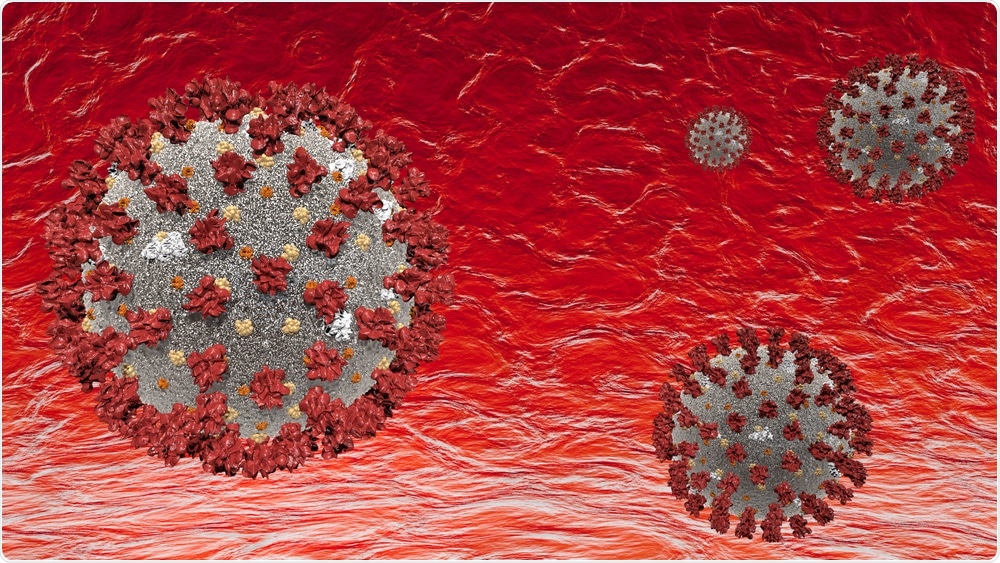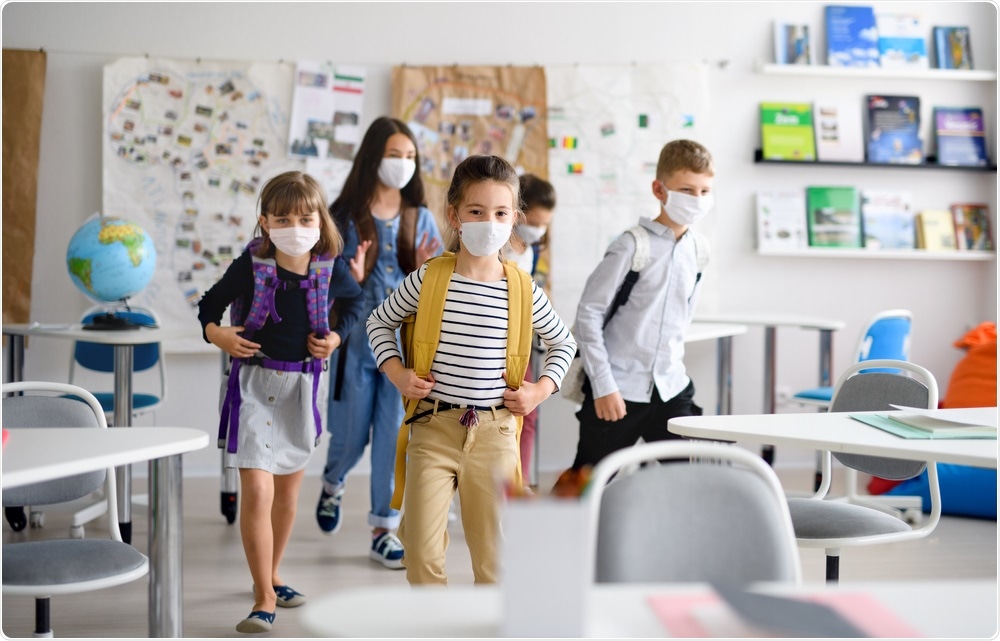How could pooling SARS-CoV-2 tests help to detect future viral outbreaks? News-Medical spoke to Dr. Jean-François Rupprecht to find out more.
What provoked your latest research into the COVID-19 pandemic?
I am a researcher from the CNRS, a French public institution. In March 2021, my fellow co-authors and I joined MODCOV19, a national modeling task force on COVID-19.
After discussing with biology experts about the promising results on the testing method called pooling (see below for a definition) for SARS-CoV-2, we decided to apply our mathematical expertise to evaluate whether such testing technique could be envisaged for mass screening of healthcare workers with the objective to track early pre- and asymptomatic infections.

SARS-CoV-2 Virus. Image Credit: Merlin74/Shutterstock.com
Please could you give an overview of the different tests available for COVID-19?
There is a large array of tests and techniques available for COVID-19; I will limit myself to the most commonly used ones.
The RT-qPCR technique is the “gold standard” for medical diagnostics in detecting the presence of very few viral molecules in a micro-liter of the sample solution. However, the test results take some time (a few hours to a few days) to come back - even though one-hour RT-qPCR setups have also emerged.
By opposition, fast tests such as antigen-tests and RT-LAMP tests can be used out of the laboratory and provide results in a minute to an hour. Antigen tests most often rely on nasopharyngeal swabs, while RT-LAMP tests can be saliva-based. Nasal swabbing may cause some discomfort, which could, as an example, refrain K12 pupils from complying to the sampling protocol.
What is meant by ‘pooling’ tests?
“Pooling” refers to the process of mixing samples from different individuals. Imagine that one hundred samples need to be tested. Rather than using one hundred tests (one per sample), one possibility is to create ten “pools” that are each composed of ten mixed samples and to use only one test for each of these pools.
If the test result for a group is positive, then at least one sample in the pool comes from an infected individual. Conversely, a negative result should, in principle, indicate that none of the combined samples contains the infectious agent.
What problems could be encountered by using this pooling method for large-scale testing?
Quite generally, there two potential main drawbacks associated with pool testing:
The first is, what do you do once a pool is positive? During the 70s and 80s in France, prospective civil servants were asked to go through a pooled testing for syphilis infections. If the pooled sample tested positive, everyone was asked to come back on a subsequent day to get retested individually; although a similar protocol was adopted during the COVID-19 pandemic at Cambridge University, UK, standard health regulations may not encourage such practices, e.g. the USA Center of Disease Control issued guidelines regarding the pooling of samples for SARS-CoV-2 detection (see references below).
The second one is a potential increase in the risk of false negatives compared to individual testing, which could delay the detection of pre-symptomatic individuals. Early in the infection, a person will shed a very low amount of the virus in their samples; that poses a challenge to all testing techniques since there is always a certain threshold below which the testing device probably will not detect the virus. That issue is particularly critical for pooling.
Combining an infected sample within a group of un-infected samples implies a dilution of the viral concentration; the number of viral copies in the sample could possibly be diluted up to the point where the testing machine will not be able to detect it. A danger is that a pooled test would miss an infected person who is not feeling sick, and who could subsequently take fewer precautions to prevent the spread of the disease.
While pooling of rapid tests could solve the first issue of isolation within positive pools to be less critical by drastically reducing the time of detection of the positive individual within the pool, the second issue of sensitivity becomes even more substantial.
In many cases, pooled testing is intended to be an added layer of protection and should not replace mask-wearing or other precautions. Whether regular testing would have an impact (positive or negative) on the adhesion to protective measures is a question to ask epidemiologists. (see this Nature press article entitled “we did not model that people would go to a party if they tested positive”).

Pooled Testing. Image Credit: DesignPrax/Shutterstock.com
Can you describe how you carried out your latest research into pooling tests and tracking COVID-19?
Our starting question was: what is the proportion of individuals currently detected as positive through individual RT-qPCR tests be missed by pools of 5 samples? How much would that proportion change if the number of samples of the pool was increased to 30?
If most of the swabs from positive individuals have a concentration of virus that is very close to the detection limit of the individual RT-qPCR test, then one would expect the fraction of missed individuals through pooling to be very large. Conversely, if the concentration of swabs is very large compared to the limit of detection of individual RT-qPCR tests, then the fraction of missed individuals should be almost zero.
To estimate the impact of pooling we, therefore, needed to determine the proportion of swabs with low, intermediate, or high viral concentrations – which we obtained by analyzing several extracted clinal datasets from publications and pre-prints.
We then interpreted the differences between those datasets based on mathematical models for the viral load evolution with time. In the analyzed datasets, low viral loads were most often correlated to ancient infection (e.g. two weeks or more before the test).
Correspondingly, the proportion of swabs with low viral loads – hence the false-negative rate of pooling compared to individual tests - should depend on the stage of the epidemic within the community.
How could this research be used to aid in the earlier detection of outbreaks? What did you discover?
By regularly testing groups of people, you can detect the presence of the virus very early in the community; this early warning system tells you when to implement preventative measures. Rather than waiting for the first person to get sick, you implement action as soon as a group tests positive. This reduces the duration of the silent epidemic spread.
Beyond the objective of breaking transmission chains, we find that pools are extremely efficient at estimating the viral fraction of positive individuals (the prevalence). Let’s take an example: a screening is performed within a community with an existing prevalence at 2% (to be discovered). With a budget of 200 individual tests, the measured prevalence is to be estimated around 1-3% with 95% confidence. However, if we use a group testing method with a pool size of 60 individuals, we only need 10 pool tests to get the same results.
Such estimates of the prevalence could serve as a metric to help scale prevention measures within a predefined graded response scheme - e.g. in a college university campus, the decision to switch to remote teaching could be triggered once the critically measured prevalence is reached. Surveillance protocols based on sample pooling have been implemented in several universities across the United States, including Duke University and the State University of New York, but also at Liège University (Belgium) as well as at Nottingham and Cambridge universities (United Kingdom).
Though highly dependent on model hypothesis, we concluded in our article that, through random daily testing of 256 individuals among a community of 4000 would result in an 80% of chance in detecting an outbreak that would involve more than 20 infected individuals; in practice, these 256 samples could be analyzed in a single RT-qPCR cycle each day if the samples are pooled by groups of 16; the loss in sensitivity in a pool of 16 is assumed in this calculation to be of the order of -20%, which in order of magnitude corresponds to the estimate given in a publication on saliva pooling (Watkins et al. bioRxiv, see reference below) as well as estimated through our analysis of the viral load distribution found in several clinical datasets from nasopharyngeal samples.
Do you believe that with further research, pooled testing will become a more frequently used tool?
Yes. My hopes are that vaccinations will reduce viral circulation to very low levels.
Pooling is more efficient at enhancing the screening capacities when the prevalence is low. A reduction in the incidence rate may also imply newly available testing capacities which could be allocated to large-scale screenings, targeted for example against asymptomatic spread among young people at school. Several companies in the USA already propose saliva-based pool sampling for school environments.
By enhancing screening capacity, pooling might play a role in the detection of new variants – although, in some not-so-distant future, Next Generation Sequencing protocols might bypass the limitations of pooling, combining sensitivity, individual results, and high-yield testing capacities.
What are the next steps in your research?
Our work is theoretical; we need to provide a mathematical framework detailing the probabilities that individuals in the community have a low or large viral concentration within their samples. Correlating such probabilities to the epidemic stage is a complex task that would need to be addressed in collaboration with epidemiologists.
As such, we cannot directly answer the question any practitioner will ask, namely "how do I adapt the Brault et al. PLOS Comp Biology workflow to my specific situation (nursing home/school, etc...)".
To answer that question, one could envisage the development of an app that would help practitioners to decide of the size of their pools. Inputs would be information about the screening context (e.g. number of individuals in the community, the best estimate of the local prevalence).
The output of the app/software would be a given number of samples to be pooled together – from 5 to 25 (a typical range used in the State University of New York campuses student screening, fall 2020) or even 30 samples (as mentioned among nursing homes in Germany, March-April 2020). Designing such an app would likely require collaborations with epidemiologists, medical data, and IT developers.

School Children. Image Credit: Halfpoint/Shutterstock.com
Where can readers find more information?
I would recommend the following websites, official guidelines, and scientific papers:
- The recommendations of the Center of Disease Control and Prevention of the United States of America, formalizing the distinction between diagnosis, screening, and surveillance. Interim Guidance for Use of Pooling Procedures in SARS-CoV-2 Diagnostic, Screening, and Surveillance Testing, Center for Disease Control and Prevention. 1st August 2020.
- Created by a team of researchers and popular science aficionados, AdiosCorona is a website gathering expert advice from scientists around the world on COVID-19; this first article refers to the interest of pooling; a second on the issue of false-negatives.
- An article reporting the first use to date of pooled testing on 2,888 nasopharyngeal samples tested in groups of ten. The 3 positives detected were detected at the end of February 2020, which makes it possible to date the emergence of the viral infection in the state of California. Hogan, C. A., Sahoo, M. K., & Pinsky, B. A. (2020). Sample pooling as a strategy to detect community transmission of SARS-CoV-2. Jama, 323(19), 1967-1969.
- An evaluation of the sensibility of large pools has been presented in the journal Nature: Mutesa et al. Nature (2020).
- An evaluation of the sensitivity of saliva pool tests (size 5 to 20) is available on medRxiv: Watkins et al. medRxiv.
About Dr. Jean-François Rupprecht
Dr. Rupprecht a researcher from the Centre National de la Recherche Scientifique (CNRS) based at the Aix-Marseille University. He is a group leader of the Turing Center for Living System; his group is interested in the interplay of Statistical Physics and Life Science modeling. Please find his webpage here: http://centuri-livingsystems.org/jf-rupprecht/
The content of Dr. Rupprecht’s interview should not guide clinical practice.